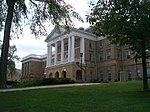|
University of Wisconsin–Madison College of Agricultural and Life Sciences The University of Wisconsin–Madison College of Agricultural and Life Sciences is one of the colleges of the University of Wisconsin–Madison. Founded in 1889, the college has 15 academic departments, 23 undergraduate majors, and 49 graduate programs.[1] CALS receives $78.7 million in research funding[1] comprising thousands of individual research projects, whose scope range from the fundamental challenges of science to the immediate problems and opportunities facing Wisconsin farms and businesses. It operates 12 agricultural research stations across the state. CALS has an average undergraduate population of 3,300 students. It’s also home to over 800 graduate students pursuing masters and doctoral degrees.[2] It offers majors in 25 areas, including Agriculture and Applied Economics, Biochemistry, Biology, Food Science, Science Communication, Genetics, and others. Undergraduate students are encouraged to participate in research programs. Students may also participate in a study-abroad program. Academic majorsThe college offers 23 undergraduate majors, which are grouped into five areas of study: health and nutrition; food and agriculture; biological sciences; sustainability, natural resources and environment; and business, communication and society. [3] Academic departmentsCALS has 15 academic departments [4] that instruct students and carry out research in areas such as food systems; ecosystems; climate change; bioenergy and bioproducts; economic and community development; and health and wellness.
HistoryIn 1885 the university began offering a winter course for farmers, the Agriculture Short Course, which was greatly developed and enhanced by Ransom Asa Moore from 1895 until 1907 and continues today as the Farm and Industry Short Course. In 1889 the university put all of their agricultural offerings under a new College of Agriculture, with W.A. Henry as dean.[5] Professors listed in the 1896 Agricultural Short Course for the College of Agriculture at the University of Wisconsin–Madison listed popular professors such the Dean of the College of Agriculture, W.A. Henry (Feeds and Feeding), S.M. Babcock (Agricultural Chemistry; Farm Dairying), F.H. King (Agricultural Physics, Agricultural Mechanics, and Meteorology), E.S. Goff (Plant Life, Horticulture, and Economic Entomology), H.L. Russell (Bacteriology), J.A. Craig (Breeds: Breeding and Judging Live Stock), Wm. A. Scott (Economics of Agriculture), C.I. King (Practical Mechanics), Mr. R.A. Moore (Parliamentary Procedures and Book-keeping), A.B. Sayles (Farm Dairying), Fred. Cranefield (Assistant in Green House Instruction), and the previous instructor in Veterinary Science, W.G. Clark, V.S. The building that housed the College of Agriculture was originally created in 1889 and was centered in South Hall on Bascom Hill until the fall of 1903 when the first classes were held in the brand new College of Agriculture and Life Sciences building, where it has since remained.[6] "The college has evolved and grown over the decades to reflect changes in the fabric of society and in the areas of knowledge that it studies. Practical studies related to crop and livestock production and farm life gradually delved deeper as scientists strove to understand the underlying biological processes. Today the college generates new knowledge about agriculture, natural resources management and protection, human health and nutrition, community development and related topics. Faculty and staff in 15 academic departments and a number of interdisciplinary programs carry out these lines of study."[5] John Rector Brown was the chair of the College. The school had a Rural Artists Program, including an Artist-in-Residence position which started when Brown was chair. John Steuart Curry was the first Artist-in-Residence.[7] See alsoReferences
|
